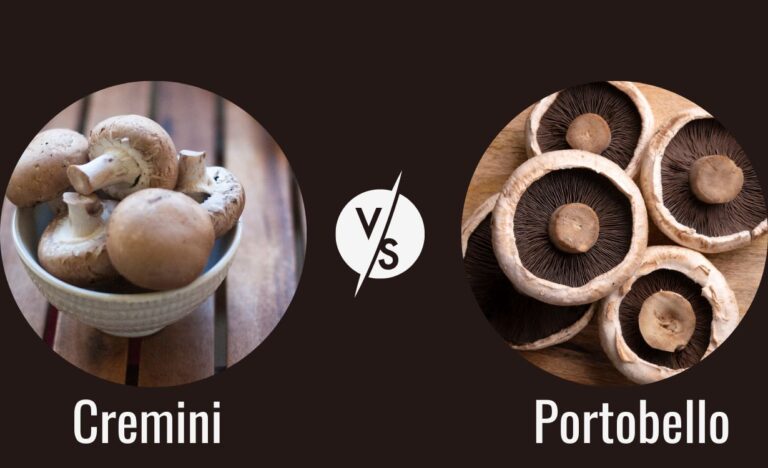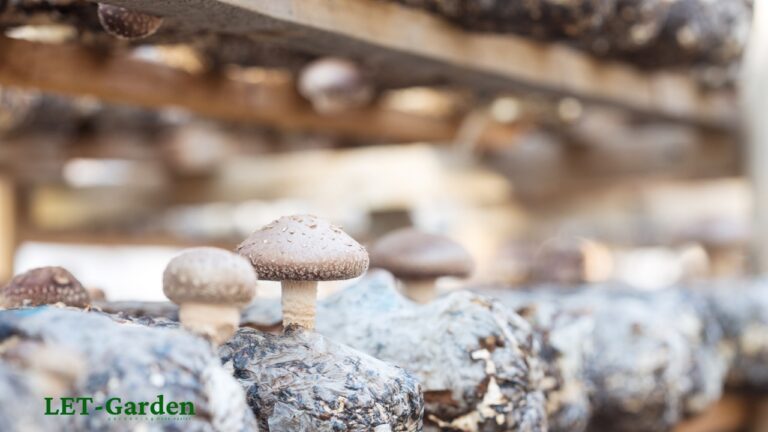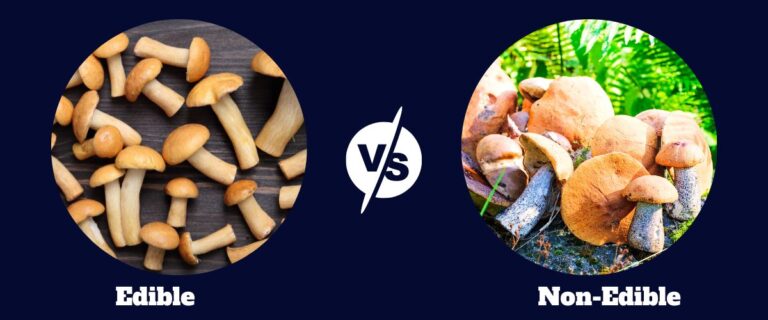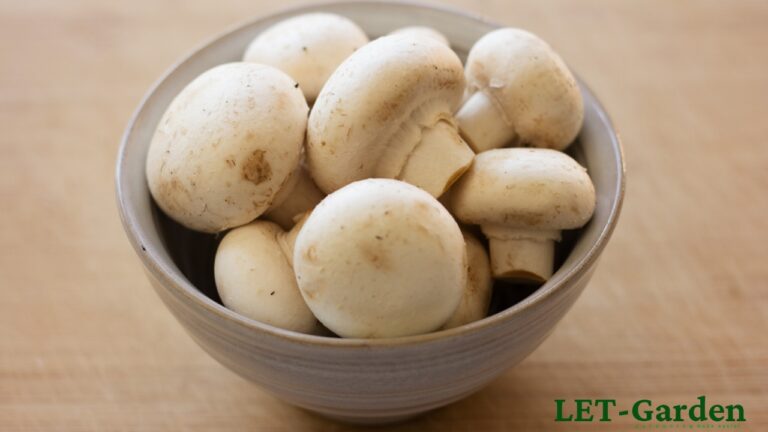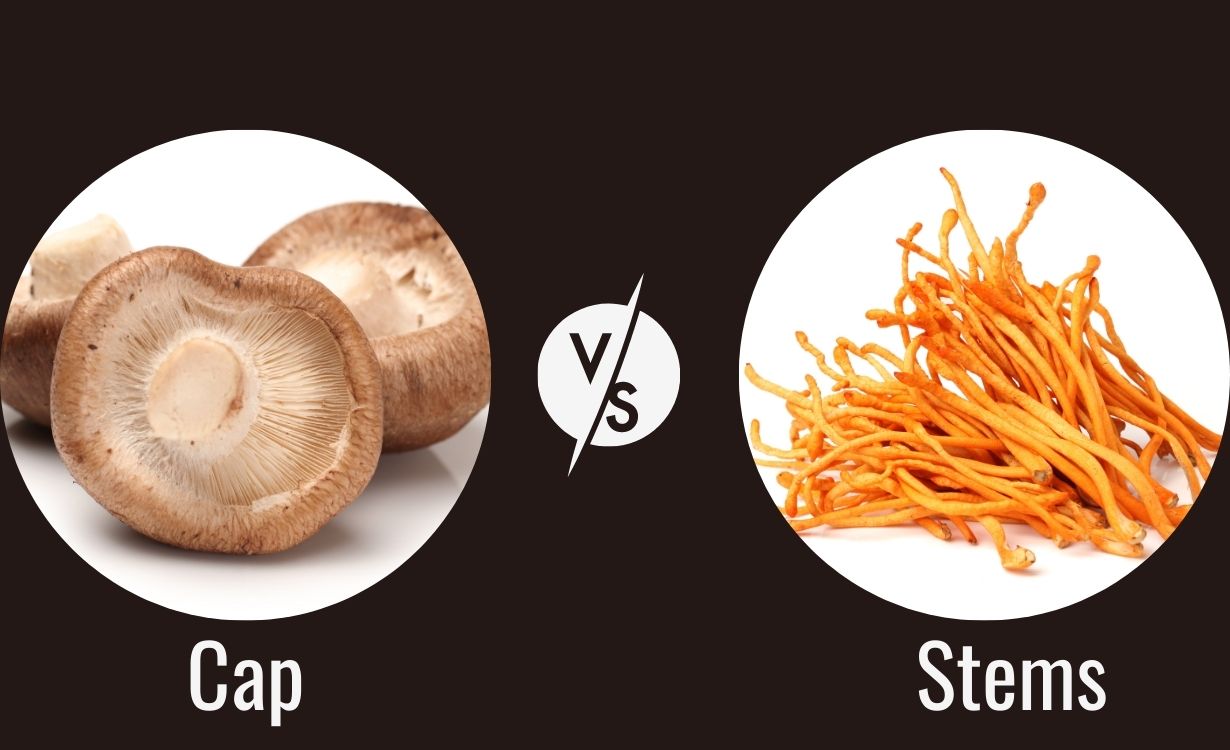
Mushrooms Caps vs Stems
Mushrooms are one of the most versatile and beloved ingredients in the culinary world. From classic dishes like mushroom risotto to modern creations like mushroom burgers, this fungus has become a staple in many kitchens around the globe. But what exactly makes up a mushroom, and what are the differences between its parts? In this blog post, we’ll explore the anatomy of mushrooms and focus on the mushrooms stems vs caps, two of the most distinctive parts of this unique ingredient.

We’ll delve into the cooking differences between mushroom stems and caps, examine their potential effects on the body, and discuss how to choose the right part of the mushroom for your desired potency. Whether you’re a seasoned mushroom enthusiast or just starting to explore this fascinating ingredient, this post will provide you with the knowledge you need to take your cooking to the next level.
Mushroom Stems vs Caps Cooking
When it comes to cooking with mushrooms, the stem and cap offer distinct textures and flavors that can be highlighted in different ways. Understanding the differences between these two parts of the mushroom can help you create dishes that are perfectly balanced and flavorful. In this section, we’ll explore the texture and flavor differences between stems and caps, the best cooking methods for each, and some delicious recipes that highlight their unique qualities.
Texture and Flavor Differences Between Stems and Caps
- Mushroom caps are typically meatier and firmer, with a slightly nutty flavor.
- Mushroom stems are softer and more delicate, with a slightly earthy flavor.
- Both parts of the mushroom can be used in a variety of dishes, but each offers a different texture and flavor profile that can be emphasized in different ways.
Best Cooking Methods for Each Part of the Mushroom
- Mushroom caps are great for grilling, sautéing, and roasting. They hold up well to high heat and can develop a rich, caramelized flavor when cooked properly.
- Mushroom stems are ideal for soups, stews, and sauces. They soften easily and can be pureed or blended to create a silky texture.
- When cooking with both mushroom stems and caps, it’s important to cook them separately to avoid overcooking one part while the other is still underdone.
Recipes that Highlight the Unique Qualities of Mushroom Stems and Caps
- Mushroom stem soup: A simple, comforting soup that showcases the delicate flavor and texture of mushroom stems.
- Grilled portobello caps: A classic dish that highlights the meaty texture and nutty flavor of mushroom caps.
- Mushroom and barley risotto: A hearty, flavorful dish that uses both mushroom caps and stems to create a balanced, satisfying meal.
Whether you’re a seasoned mushroom enthusiast or just starting to experiment with this versatile ingredient, cooking with mushroom stems and caps can add depth and complexity to your dishes. By understanding the texture and flavor differences between these two parts of the mushroom and using the right cooking methods, you can create dishes that are both delicious and satisfying.
Mushroom Caps vs Stem Effects On the Body
When it comes to the nutritional benefits of mushrooms, both the stem and cap provide unique advantages. However, there are differences in the way our bodies digest and absorb these nutrients. Additionally, consuming one part of the mushroom over the other may have varying health effects.
Nutritional benefits of both parts of the mushroom:
Mushroom stems and caps both offer an array of vitamins, minerals, and antioxidants. The stems are a great source of dietary fiber, which helps regulate digestion and keeps you feeling full. They also contain ergothioneine, a powerful antioxidant that helps protect cells from oxidative stress. Mushroom caps, on the other hand, are rich in B vitamins, including riboflavin, niacin, and pantothenic acid. They also contain selenium, a mineral that plays a key role in thyroid function and immune system health.
Differences in the way the body digests and absorbs nutrients from stems and caps:
One key difference between mushroom stems and caps is the presence of chitin, a tough, indigestible fiber that makes up the cell walls of many fungi. Mushroom stems have a higher chitin content than caps, which means they may be more difficult for the body to break down and absorb nutrients from. This may be an important consideration for people with digestive issues or conditions that affect nutrient absorption.
Possible health effects of consuming one part of the mushroom over the other:
While both mushroom stems and caps offer valuable health benefits, some research suggests that consuming one part of the mushroom over the other may have specific health effects. For example, one study found that a compound in mushroom caps called ergothioneine may help protect against neurodegenerative diseases like Alzheimer’s. Another study found that a compound in mushroom stems called beta-glucans may help support immune system function.
Moreover, both mushroom stems and caps provide a range of nutritional benefits and can be incorporated into a healthy diet in a variety of ways. While there are differences in the way the body digests and absorbs nutrients from these parts of the mushroom, both are valuable sources of vitamins, minerals, and antioxidants. By understanding the unique qualities of each part of the mushroom, you can make informed choices about how to incorporate this delicious and nutritious ingredient into your meals.
Mushroom Stem vs Cap Potency
Mushrooms are well-known for their potential to have psychoactive effects on the human mind and body. However, not all parts of the mushroom are created equal when it comes to potency. The stem and cap of a mushroom can contain different levels of psychoactive compounds, which can affect the overall potency and effects of the mushroom. Here are some factors that affect the potency of mushroom stems and caps, as well as some tips on how to choose the right part of the mushroom for your desired effects.
Factors that affect the potency of mushroom stems and caps:
- Species: Different species of mushrooms have varying levels of psychoactive compounds. For example, the psilocybe cubensis mushroom, which is commonly used for its psychedelic effects, has more of its concentration in its caps than in its stems.
- Age: As mushrooms mature, their psychoactive compounds can change. Some species may have higher levels of psychoactive compounds in their caps when they are young, while others may have higher levels in their stems when they are more mature.
- Environment: The environment in which mushrooms grow can also affect their potency. For example, mushrooms that grow in nutrient-rich soil may have higher levels of psychoactive compounds than those that grow in less fertile soil.
Differences in psychoactive compounds between the two parts of the mushroom:
- Psilocybin and psilocin: These two compounds are responsible for the psychoactive effects of many species of mushrooms. While both compounds are found in the caps and stems of mushrooms, research has shown that the concentration of these compounds can be higher in the caps than in the stems.
- Baeocystin: This lesser-known compound is also found in many species of mushrooms and can contribute to their psychoactive effects. Research has shown that baeocystin is typically more concentrated in the stems than in the caps.
How to choose the right part of the mushroom for your desired effects:
- Determine your desired effects: Different parts of the mushroom may have different effects on the mind and body. For example, if you’re looking for a more intense psychedelic experience, you may want to choose mushrooms with higher levels in their caps.
- Research the species: Not all species of mushrooms have the same potency or effects. Do your research to find out which species have the psychoactive compounds you’re looking for and which parts of the mushroom contain them.
- Experiment: The best way to find out which part of the mushroom works best for you is to experiment with different parts and species. Start with small doses and work your way up until you find the right combination for your desired effects.
However, understanding the differences in potency between mushroom stems and caps can help you choose the right part of the mushroom for your desired effects. Factors such as species, age, and environment can all affect the potency of different parts of the mushroom, and it’s important to do your research and experiment to find what works best for you.
Eating Mushrooms Caps vs Stems
Mushrooms are an incredibly versatile ingredient, and both the cap and stem can be used in a variety of dishes. However, personal preferences and cultural differences can greatly influence the way people consume mushrooms. In this section, we’ll take a closer look at the advantages and disadvantages of eating mushroom caps vs stems, and provide some tips for incorporating both parts of the mushroom into your diet.
Personal Preferences and Cultural Differences in Mushrooms Consumptions
Some people prefer to eat only the caps of mushrooms, while others enjoy the whole mushroom, including the stem. Personal preferences can be influenced by factors such as texture, flavor, and appearance. In some cultures, mushroom stems are considered to be less desirable or even inedible, while in others they are considered a delicacy. For example, in Chinese cuisine, shiitake mushroom stems are often used in soups and stir-fries.
Pros and Cons of Eating mushrooms Stems vs Caps
Mushroom caps tend to be larger and more visually appealing than stems, and they have a meatier texture and stronger flavor. However, stems also have their advantages. They are often more tender and easier to cook than caps, and they can be used to add bulk and fiber to dishes. Additionally, mushroom stems contain many of the same nutritional benefits as the caps, including vitamins, minerals, and antioxidants.
Advantages of Eating Mushroom Caps:
- Meatier texture and stronger flavor: Mushroom caps have a meatier texture and stronger flavor, making them a popular choice in many dishes.
- Larger and more visually appealing: The caps are usually larger and more visually appealing than the stems, which can make them a more attractive option in certain recipes.
- Can be used as a vessel: Mushroom caps can be used as a vessel for other ingredients, such as stuffing or toppings, which can add depth and flavor to a dish.
- Rich in umami: Mushroom caps are rich in umami, a savory flavor that is often associated with meat and adds depth to dishes.
- Can be cooked in a variety of ways: Mushroom caps can be grilled, roasted, sautéed, or fried, which allows for a variety of cooking methods and flavor profiles.
Disadvantages of Eating Mushroom Caps:
- Expensive: Mushroom caps can be more expensive than the stems, which may limit their accessibility for some people.
- Texture may not be preferred: The meaty texture of mushroom caps may not be preferred by some people, especially those who prefer a softer texture in their food.
- More prone to damage: Mushroom caps can be more prone to damage during transport and storage, which can impact their quality and freshness.
- More difficult to clean: Mushroom caps can be more difficult to clean than the stems, as dirt and debris can get trapped in the gills and crevices.
- Lower fiber content: Mushroom caps have a lower fiber content than the stems, which may be a disadvantage for those looking to increase their fiber intake.
Advantages of Eating Mushroom Stems:
- Tender and easy to cook: Mushroom stems are often more tender and easier to cook than the caps, which can make them a convenient option for busy cooks.
- Can add bulk and fiber: Mushroom stems can add bulk and fiber to dishes, which can help promote feelings of fullness and aid in digestion.
- Versatile: Mushroom stems can be used in a variety of dishes, including soups, stews, stocks, and sauces.
- Contain similar nutritional benefits: Mushroom stems contain many of the same nutritional benefits as the caps, including vitamins, minerals, and antioxidants.
- Can be more affordable: Mushroom stems can be more affordable than the caps, which may make them a more accessible option for some people.
Disadvantages of Eating Mushroom Stems:
- Can be less visually appealing: Mushroom stems can be less visually appealing than the caps, which may make them a less attractive option in certain dishes.
- May be considered less desirable: In some cultures, mushroom stems are considered to be less desirable or even inedible, which can limit their use in certain recipes.
- Can be tough and woody: Some mushroom stems can be tough and woody, which can make them unpleasant to eat.
- The flavor may not be as strong: Mushroom stems may not have the same strong flavor as the caps, which can impact the overall taste of a dish.
- More difficult to cut: Mushroom stems can be more difficult to cut than the caps, as they can be thicker and tougher.
Tips for Incorporating Both Parts of the Mushroom into Your Diet
To get the most out of your mushrooms, consider incorporating both the caps and stems into your dishes. Here are a few tips for doing so:
- Use mushroom stems in soups, stews, and stocks to add depth of flavor and nutrition.
- Chop mushroom stems finely and use them to bulk up meatloaf or vegetarian burgers.
- Grill or roast whole mushrooms with the stems intact to preserve their natural shape and texture.
- Use mushroom caps as a vehicle for other ingredients, such as stuffing or toppings.
- Experiment with different types of mushrooms and cooking methods to find the perfect balance of caps and stems in your dishes.
When it comes to mushrooms, both the caps and stems have their own unique qualities and can be used in a variety of dishes. While personal preferences and cultural differences may influence the way people consume mushrooms, incorporating both parts into your diet can provide a wide range of nutritional benefits and culinary possibilities. By using the tips outlined in this section, you can take advantage of all that mushrooms have to offer and elevate your cooking to the next level.
FAQs on Stems vs Caps Mushrooms
Mushrooms are versatile ingredients that can be used in a variety of dishes. However, many people have questions about how to prepare and eat them. Below, we’ll answer some of the most common questions about mushroom cap vs mushroom stem, from what to eat with mushroom caps to whether it’s safe to eat raw mushrooms.
What do you eat with mushroom caps?
When it comes to stuffed mushroom caps, the options are endless! Some popular dishes to pair with mushroom caps include chicken parmesan, French onion soup, baked clams, garlic bread, spaghetti squash, pasta salad, cheesy biscuits, and mozzarella sticks.
Can you eat raw mushroom caps?
Yes, you can eat raw mushroom caps if you prefer. However, cooking mushrooms can help bring out their flavor and make them more palatable. All fresh mushrooms that you can purchase at a grocery store or market are safe to eat either cooked or raw.
What do I do with mushroom stems?
Mushroom stems can be just as versatile as mushroom caps. Here are nine different ways you can use mushroom stems: in soups, to make broths and stocks, in pasta dishes, as a filling, for stuffing, to make duxelles, to make ragu, to create blended burgers.
Is it OK to eat mushroom stems?
Yes, it’s perfectly safe to eat mushroom stems. In fact, many people discard them when cooking with mushrooms, but the stems contain many of the same nutritional benefits as the caps. Although parts like portobello’s gills are often removed, most mushroom stems won’t hurt you.
Should you throw away mushroom stems?
If the mushroom stems are tough, you can snap them off and discard them, or save them to add to stock. Even if the stems are not tough, it’s still a good idea to trim off and discard any dry ends to ensure a better texture once you cook them.
Do you eat all parts of a mushroom?
Yes, all parts of the fruiting body of a mushroom are edible, including the cap, gills, ring, and stem. However, depending on the species of mushroom, some parts may be tougher than others. It’s important to know the type of mushroom you have before consuming it.

Hi, I’m Miles, the lead team member behind Gardeem.com. Besides being a passionate grower and writer, I’m a husband, father and grandfather to three! I started Gardeem in 2017 to provide simple and reliable gardening advice to everyone, regardless of their ability levels.



